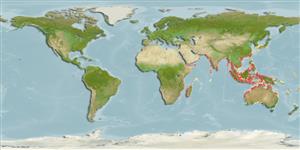Actinopterygii (ray-finned fishes) >
Siluriformes (Catfish) >
Ariidae (Sea catfishes) > Ariinae
Etymology: Arius: Greek, arios, areios = dealing with Mars, warlike, bellicose (Ref. 45335).
Environment / Climate / Range
Ecology
Marine; brackish; demersal; amphidromous (Ref. 51243). Tropical, preferred ?
Indo-West Pacific: India through neighboring coastal states (Pakistan, India, Bangladesh and Myanmar, Ref. 4833) to Singapore, South China Sea.
Size / Weight / Age
Maturity: Lm ? range ? - ? cm
Max length : 40.0 cm SL male/unsexed; (Ref. 38478); common length : 15.0 cm SL male/unsexed; (Ref. 4833)
Dorsal
spines
(total): 1;
Anal
soft rays: 17 - 22. Head shield smooth anteriorly with a series of granules and rugae posteriorly. Adipose fin with a large black spot. Lateral line bifurcating at the base of tail. Gill rakers present on the hind aspect of all gill arches. Dorsal spine with a filament at its tip. Moderately deep caudal peduncle, 1.5 to 2.1 (mean 1.8) in its depth. (Ref. 38478).
Common in estuaries, tidal rivers and brackish water lakes. Feeds mostly on invertebrates. Caught mainly with bagnets, dipnets and bamboo stake traps, also on hook and line (Ref. 3290).
Life cycle and mating behavior
Maturity | Reproduction | Spawning | Eggs | Fecundity | Larvae
Kailola, P.J., 1999. Ariidae (=Tachysuridae): sea catfishes (fork-tailed catfishes). p. 1827-1879. In K.E. Carpenter and V.H. Niem (eds.) FAO species identification guide for fishery purposes. The living marine resources of the Western Central Pacific. Vol. 3. Batoid fishes, chimaeras and bony fishes part 1 (Elopidae to Linophrynidae). FAO, Rome. (Ref. 38478)
IUCN Red List Status (Ref. 115185)
CITES (Ref. 94142)
Not Evaluated
Threat to humans
Traumatogenic (Ref. 58010)
Human uses
Fisheries: commercial
More information
Common namesSynonymsMetabolismPredatorsEcotoxicologyReproductionMaturitySpawningFecundityEggsEgg development
ReferencesAquacultureAquaculture profileStrainsGeneticsAllele frequenciesHeritabilityDiseasesProcessingMass conversion
Tools
Special reports
Download XML
Internet sources
Estimates of some properties based on models
Phylogenetic diversity index (Ref.
82805): PD
50 = 0.5000 [Uniqueness, from 0.5 = low to 2.0 = high].
Bayesian length-weight: a=0.00479 (0.00252 - 0.00908), b=3.12 (2.95 - 3.29), in cm Total Length, based on LWR estimates for this (Sub)family-body shape (Ref.
93245).
Trophic Level (Ref.
69278): 3.5 ±0.37 se; Based on food items.
Resilience (Ref.
69278): Medium, minimum population doubling time 1.4 - 4.4 years (Preliminary K or Fecundity.).
Vulnerability (Ref.
59153): Moderate to high vulnerability (50 of 100) .
